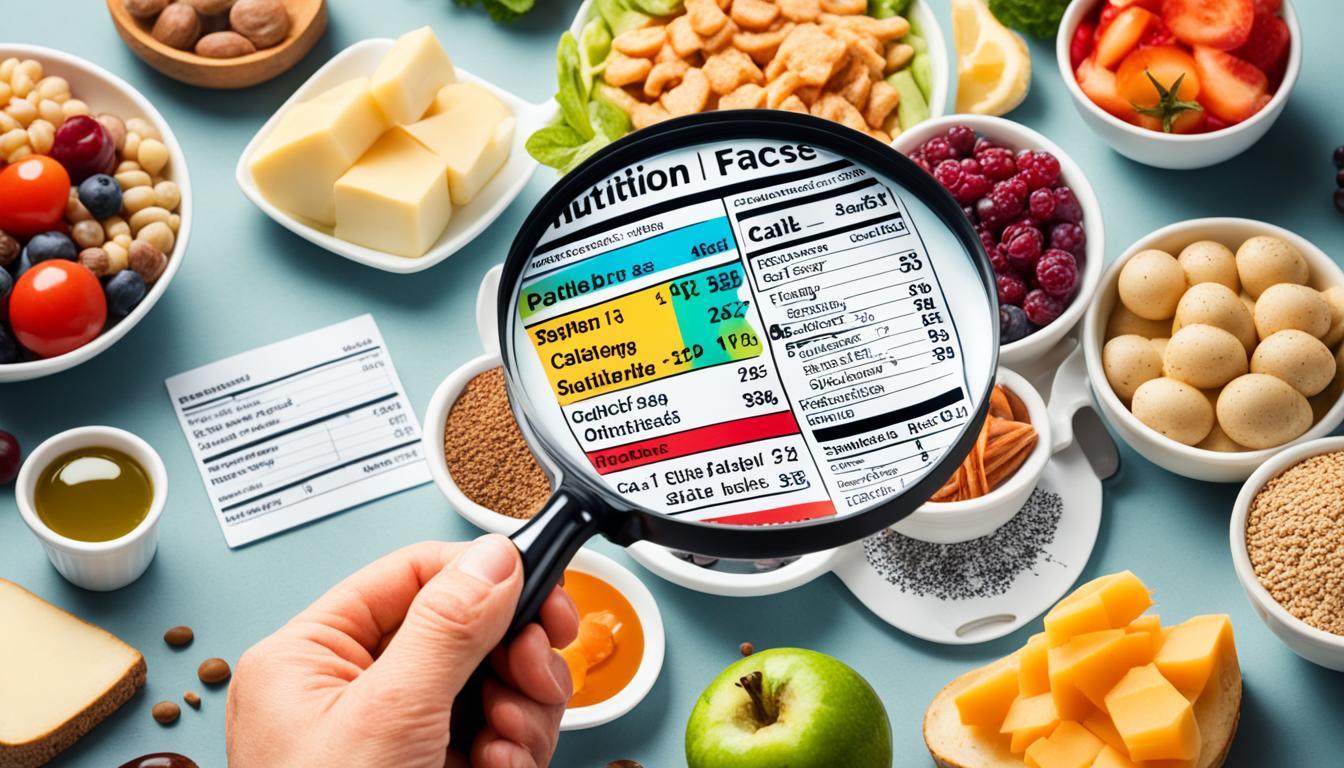Demystifying Nutrition Labels: Your Guide

Welcome to our comprehensive guide on understanding and interpreting nutrition labels. Have you ever found yourself standing in the grocery store aisle, staring at the back of a food package, trying to decipher the cryptic information presented? How often do you end up feeling confused, wondering if you've made the right choice?
Decoding the language of nutrition labels can be a challenge, but it is an essential skill for making informed food choices. Understanding these labels empowers you to take control of your diet and make choices that align with your health goals.
In this guide, we will demystify nutrition labels and provide you with the knowledge and tools to navigate the vast sea of information they present. From deciphering serving sizes and calories to understanding the role of carbohydrates and fats, we'll break it down step by step.

Key Takeaways:
Understanding nutrition labels is crucial for making informed food choices.
Decoding serving sizes and calories helps you control your portion sizes.
Interpreting carbohydrate and fat content allows you to balance your macronutrient intake.
Reading ingredient lists helps you avoid hidden sugars and make healthier choices.
Comparing nutritional values empowers you to select healthier options.
Understanding Nutrition Facts and Their Health Implications
In this section, we will delve into the various components of nutrition labels. Understanding nutrition facts is crucial when it comes to making informed food choices. By interpreting nutrition labels, you can gain valuable insight into the nutritional content of the foods you consume.
The Importance of Serving Size
One of the key aspects highlighted on nutrition labels is the serving size. It is essential to pay attention to this information as it determines the significance of the other nutritional values listed. Serving sizes may vary from product to product, so be mindful of adjusting your portions accordingly.
Interpreting Calories and Energy Provision
Calories play a vital role in understanding the energy provided by a particular food item. By interpreting calorie content, you can make informed decisions about the energy intakeand manage your overall dietary needs. Remember, calorie requirements may vary based on individual factors such as age, gender, and activity level.
Navigating Through Carbohydrates and Sugars
Understanding the amount and types of carbohydrates and sugars in your food is essential for managing a balanced diet. Carbohydrates are a primary source of energy, while sugars can contribute to excess calorie intake. By paying attention to these values, you can make conscious choices regarding your sugar and carbohydrate consumption.
Significance of Fiber in Your Diet
Fiber is an important component of our diet that aids in digestion, promotes healthy bowel movements, and helps maintain overall gut health. Nutrition labels often indicate the amount of dietary fiber present in a serving. By ensuring an adequate intake of fiber, you can support your digestive system and contribute to a well-rounded diet.
Decoding Fat Content: Choosing Healthier Options
In this section, we will explore the importance of understanding and decoding fat content on nutrition labels. By deciphering fat content, you can make informed choices about the types of fats you consume, leading to healthier options for your diet.
Fats are an essential macronutrient that provides energy, aids in the absorption of vitamins, and supports various bodily functions. However, not all fats are created equal. It's crucial to recognize the different types of fats and their effects on our health.
Types of Fats:
Saturated Fats: These fats are primarily found in animal products and some plant oils, such as coconut oil and palm oil. Consuming high amounts of saturated fats can increase your risk of heart disease.
Trans Fats: Trans fats are artificially produced through hydrogenation, which converts liquid oils into solid fats. These fats are commonly found in processed foods, fried foods, and some margarines. They are known to increase bad cholesterol levels and raise the risk of heart disease.
Monounsaturated Fats: These fats are considered to be healthier options. They can be found in olive oil, avocados, and certain nuts. Monounsaturated fats can help improve heart health and lower bad cholesterol levels.
Polyunsaturated Fats: Polyunsaturated fats include omega-3 and omega-6 fatty acids. They are found in fatty fish, walnuts, flaxseeds, and soybean oil. Omega-3 fatty acidsare especially beneficial for brain health and reducing inflammation in the body.
When reading nutrition labels, it's important to pay attention to the total fat content and the breakdown of different types of fats. Aim for foods that are low in saturated and trans fats and higher in monounsaturated and polyunsaturated fats.
Remember, it's not just about avoiding all fats but rather choosing healthier fat options. Incorporating sources of monounsaturated and polyunsaturated fats into your diet can have numerous benefits for your overall health and well-being.
How to Read Nutrition Labels: A Step-by-Step Approach
In this section, we will provide you with a step-by-step approach to reading nutrition labels. Understanding the information presented on these labels is key to making informed choices about the foods you consume.
Inspecting the Ingredient List for Hidden Sugars
One essential step in deciphering nutrition labels is inspecting the ingredient list. This list provides valuable information about the contents of the product and can help you identify hidden sources of sugar. Look out for ingredients such as:
High-fructose corn syrup
Dextrose
Fructose
Sucrose
Glucose
These ingredients all indicate the presence of added sugars, which can contribute to an unhealthy diet. Be mindful of the position of these ingredients on the list, as they are listed in descending order by weight, with the most abundant ingredient listed first.
To gain a better understanding of the sugar content in a product, ensure you also check the total grams of sugar listed in the nutrition facts panel. This information will give you a clearer picture of the sugar content, helping you make informed choices.
How to Identify Sugar Alcohols and Their Effect
Understanding sugar alcohols is another crucial aspect of reading nutrition labels. Sugar alcohols, such as xylitol and sorbitol, are commonly used as sweeteners in sugar-free or reduced-sugar products. While these sweeteners provide fewer calories than regular sugar, they can still affect blood sugar levels.
When examining the nutrition facts panel, look for the term "sugar alcohols" under the total carbohydrate section. Take note of the grams of sugar alcohols listed and consider their impact on your overall carbohydrate intake. It's important to remember that excessive consumption of sugar alcohols can cause digestive issues, including bloating and diarrhea, particularly if consumed in large quantities.

Understanding the Impact of Sugar Alcohols
Sugar alcohols have a lower glycemic index compared to regular sugar, meaning they have a smaller impact on blood sugar levels. However, they can still affect your overall carbohydrate intake, so it's crucial to consider them when making food choices. Be mindful of any potential gastrointestinal side effects that may arise from consuming excessive amounts of sugar alcohols.
By following this step-by-step guide to reading nutrition labels, inspecting ingredient lists, and understanding sugar alcohols, you will be equipped to make informed decisions about the nutritional content of the foods you consume.
Comparing Nutritional Values for Better Food Choices
When it comes to making better food choices, understanding the nutritional content of different products is key. One way to do this is by comparing the nutritional values of various options. By comparing nutrition labels, you can gain valuable insights into the composition of different foods and make more informed decisions about what you consume.
Comparing nutritional values allows you to assess the nutrient content, portion sizes, and ingredients in different products. This information can help you identify healthier options, avoid excessive sugar, sodium, or unhealthy fats, and select products that align with your dietary needs and goals.
When comparing nutritional values, focus on important factors such as:
Calorie content: Understanding the energy value of different foods can help you manage your daily caloric intake and maintain a balanced diet.
Macronutrients: Comparing the amounts of carbohydrates, proteins, and fats can guide your choice of foods based on your specific nutritional requirements and preferences.
Vitamins and minerals: Pay attention to the presence of essential nutrients like vitamins, minerals, and antioxidants, which contribute to overall health and well-being.
Added sugars and artificial ingredients: Identifying products with high amounts of added sugars or artificial additives can empower you to make healthier, more natural choices. These components can often be found in processed foods, beverages, and snacks.
To visually depict the differences in nutritional values, take a look at the table below:
Product | Calories per Serving | Total Fat (g) | Sodium (mg) | Sugar (g) |
Product A | 150 | 5 | 200 | 10 |
Product B | 120 | 2 | 150 | 5 |
Product C | 180 | 7 | 250 | 15 |
This table highlights the variations in calories, fat, sodium, and sugar content among different products. By comparing these nutritional values, you can identify which product aligns with your dietary preferences and goals, making it easier to choose healthier options.
Deciphering Percent Daily Value (%DV) and What It Means for You
In this section, we will focus on understanding the percent daily value (%DV) and its significance on nutrition labels. The percent daily value provides information about the nutrient content in a serving of food, based on a 2,000 calorie diet.
The %DV allows you to compare and evaluate the nutritional value of different foods. It is important to note that the %DV is based on average daily intake recommendations for various nutrients and may vary depending on your individual needs and health goals.
Recognizing Low and High %DV
When interpreting the %DV, it's essential to recognize both low and high values. A low %DV indicates that the food contains minimal amounts of the specific nutrient, while a high %DV suggests that the food is rich in that nutrient.
For example, if a food product has a %DV of 5% or less for a nutrient, it is considered low. Conversely, a %DV of 20% or more signifies a high nutrient content.
Applying %DV to Your Personal Caloric Needs
To apply the %DV to your personal caloric needs, you can use the following steps:
Determine your specific daily calorie requirement based on factors such as age, sex, activity level, and overall health goals. This information can be obtained through consultation with a registered dietitian or online calculators.
Refer to the %DV on nutrition labels to assess the nutrient content in relation to your calorie needs. For example, if you aim to consume 2,000 calories per day and a food item contains 10% of the %DV for a specific nutrient, it contributes 10% towards your daily intake.
Adjust your food choices accordingly to ensure you are meeting your recommended nutrient intake while staying within your overall calorie limit. This can help you achieve a balanced and nutritious diet.
Remember, the %DV serves as a guide to help you make informed decisions about the foods you consume. It should be used alongside other factors such as individual health considerations, dietary goals, and overall nutritional needs.
Making Sense of 'Free-From' Labels: Fat-Free, Sugar-Free, and More
When browsing through food packaging, you've likely come across labels boasting of being "fat-free" or "sugar-free." But what do these 'free-from' labels really mean? In this section, we will help you navigate and interpret these labels, ensuring that you can make informed decisions about the nutritional content of the products you choose.
Understanding free-from labels is crucial for managing your dietary goals and preferences. Let's start by deciphering fat-free labels. A product labeled as "fat-free" means that it contains less than 0.5 grams of fat per serving. It's important to note that fat-free foods may still contain calories and other ingredients that you should consider when making your food choices.
Similarly, interpreting sugar-free labels requires some knowledge. Products labeled as "sugar-free" generally contain less than 0.5 grams of sugar per serving. However, they may still contain alternative sweeteners or sugar alcohols, which can contribute to the overall sweetness of the product.
Decoding free-from claims goes beyond just fat and sugar. You might also encounter labels such as "gluten-free," "dairy-free," or "allergen-free." These labels are particularly important for individuals with specific dietary restrictions or allergies. Gluten-free products, for example, are suitable for those with celiac disease or gluten sensitivities, as they don't contain any gluten-containing grains like wheat, barley, or rye. Dairy-free products, on the other hand, are intended for those who avoid lactose or have dairy allergies.
It's crucial to read the entire ingredient list and nutrition facts panel to ensure these 'free-from' claims align with your dietary needs. Labels can help you navigate the aisles and make more conscious food choices, but they should be supplemented with a comprehensive understanding of the nutritional facts.
Conclusion
Your journey towards healthy eating starts with understanding nutrition labels. By decoding the information provided on these labels, you can make informed food decisions that align with your goals for a healthier lifestyle.
We encourage you to empower yourself by taking control of your diet. By utilizing the knowledge gained from reading nutrition labels, you can make conscious choices about the foods you consume. This includes paying attention to serving sizes, calories, fat content, sugars, and other essential nutritional values.
Committing to a healthy lifestyle requires dedication and perseverance. But by integrating the practice of reading nutrition labels into your daily routine, you are actively taking steps to improve your overall well-being. Through informed food decisions, you can nourish your body with the nutrients it needs and achieve your health goals.







![[BWBL] Hammer Shaker](/web/image/product.product/1550/image_256)
![[WP24] Whey Protein Powder (Unflavored)](/web/image/product.product/3859/image_256)